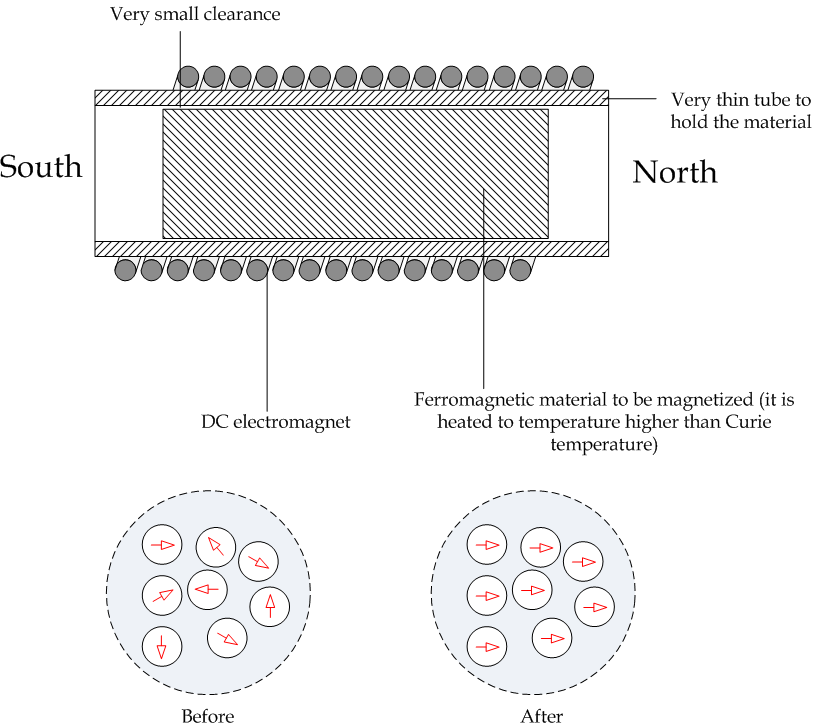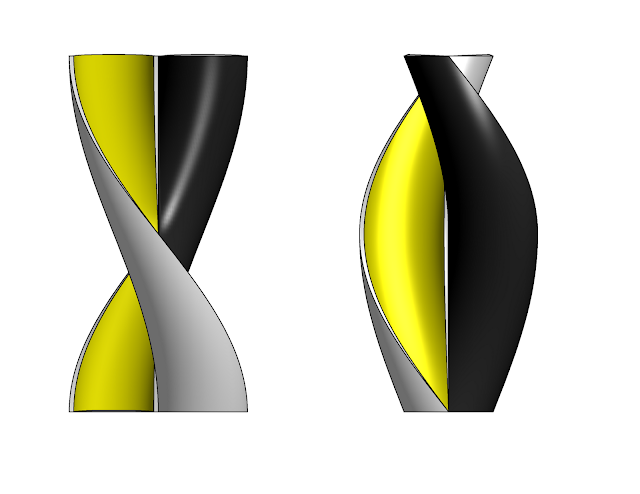Labels
- Computational Science (21)
- Mechanical Engineering (85)
- Misc. (48)
- PowerPoint (1)
- Scilab (15)
- VBA Programming (25)
Thursday, December 30, 2010
Manufacturing of permanent magnets
Manufacturing of permanent magnet has a configuration like the following figure. A ferromagnetic material is heated up till it reaches its Curie value then exposed to a very strong magnetic field in order to orient the poles of the material in one direction.
Some notes:
The stronger the magnetic field, the good orienting is.
To increase the value of magnetic field increase the number of turns and current
You should know what temperature you should heat the material to, taking in consideration heat transfer and the required time to align all grains.
We can get a DC current from an AC one using a rectifier like diode bridge.
Newton's Interpolation toolbox
Newton's interpolation for a given set of points is interpolating them to a polynomial. For a given number of points “N” the degree of the resulting polynomial will be “N-1”.
And here you are some snapshots
The following Scilab code is used for this interpolation method
And here you are some snapshots
The following Scilab code is used for this interpolation method
//This tool box is not working right for 4 points or less
labels=["Independent variable name"];
[ok,name]=getvalue("Enter the independent variable name (i.e., x, w, Shady)",labels,...
list("str",-1),["x"]);
//Generating array of random numbers (two columns width)
array=rand(10,2);
editvar array;
//don't copy and paste the following lines till you edit the array
x=array(:,1); y=array(:,2);
lst=list(x,y);
for m=1:max(size(x))-2,
n=1:max(size(x))-m;
c=(lst(m+1)(n+1)-lst(m+1)(n))./(lst(1)(m+n)-lst(1)(n));
lst(m+2)=c;end;
//Defining a protected variable "s"
s=%s;
pol=0;
for m=3:max(size(x)),
mat=1;
for n=1:m-2,
a=s-lst(1)(n);
mat=a*mat;
end;
c=mat*lst(m)(1);
pol=pol+c;
end;
pol=pol+lst(2)(1);
varn(pol,name) //Show the polynomial "pol"
|
Wednesday, December 29, 2010
Engineering Equation Solver is smashed
I wrote a code that runs on Scilab (open-source computational software like Matlab) that do one of the most important features in Engineering Equation Solver EES which is solving a set of non-linear simultaneous equations. The code is under improvement but here are some scenes.
The code also provides step control, tolerance control, iterations control, and initial guess control. You can also know the processing time and number of iterations.
The code also provides step control, tolerance control, iterations control, and initial guess control. You can also know the processing time and number of iterations.
Advantages of Helical Savonius wind turbine
The following information is copied from a patent from US Patent Office
Patent number:US 7,344,353 B2
Mar. 18, 2008
Helical wind turbine features:
[1] The turbine contains 2 or 3 blades
[2] Commonly used number of blades 2-10
[3] Preferable number of blades 3-5
[4] Non-linear portion is in the form of helix
[5] Each blade and/or the rotor section as a whole is rotationally balanced so minimal vibration is encountered
[6] In a preferred embodiment the helical blades overlap the central vertical axis so as to prevent wind from passing through the center of the rotor
[7] Non-linear portion provides lifting force to the rotor
[8] Each non-linear blade portion is preferably oriented so that the wind will impact the blade on the radially inward and downwards facing
[9] This non-linear configuration reduces the effective rotation weight
[10] Also the rotor section rotation direction and the lift direction can be adjusted by reversing the blade construction or orientation
The following information is from my point of view:
From my point of view at constant wind speed and for profile rotation of 180 or 360 degrees compared with Savonius:
[1] I think also this turbine will rotate with constant angular speed without the need of inertia [kinetic energy storage].
[2] Bending stress on the shaft cross section will be extremely reduced
[3] Fatigue on the shaft will be eliminated due to uniform torque
[4] Power output will be uniform [at least this is useful in testing]
Tuesday, December 28, 2010
Helical Savonius wind turbine shape
The following figure shows the shape of Helical Savonius wind turbine with twist angle (torsion angle) of 180 degrees. This turbine is composed of two blades and the blade section is semi-circular. Those blades were drawn using Autodesk Inventor 2010 using coil feature defined by revolution (0.5 revolution) and height.
Monday, December 27, 2010
Advantages and disadvantages of VAWT
Advantages of VAWT:
w Can capture and utilize wind coming from any direction
w Electric generator is easy to reach as it is beneath the turbine
w Usually those wind turbines have aspect ratios that the ratio between rotor diameter and height is small. So wind energy is utilized in vertical direction. On the contrary, three-bladed HAWT’s should occupy circular swept area which waste large areas in wind farms
w Simple design and manufacturing
w Since the diameter of this kind of turbines is usually small, so low centrifugal forces are there and so low stresses
w Bending on shaft is not too much as it is only resulting from wind drag, but in HAWT it is resulting from weights and centrifugal forces
w Magnetic levitation technology is easy to use to reduce mechanical losses
w In most designs, the turbine may have a base plate and the tip of this plate can run an electric generator of small wheel and then no gear box is required
Disadvantages of VAWT:
w Low values of power coefficient (efficiency) specially in drag types
w In most designs, for a given wind speed the rotational speed of the turbine is not constant because the turbine is not producing power with the same quantity at different positions of the cycle. This problem is avoided in the helical Savonius wind turbine with a twist angle of 180 degrees.
Subscribe to:
Posts (Atom)









